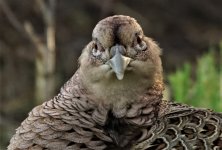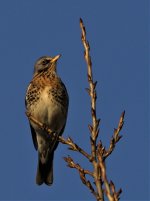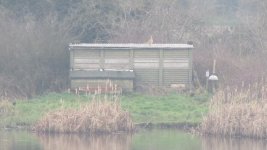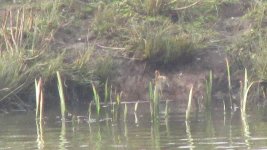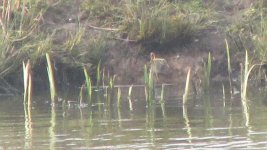2019 highlights report
A quick canter through the highlights of the last year including a first for the reserve, several records of species not recorded for some considerable time, various record counts and a number of notable breeding successes.
Two events particularly worthy of mention were the extraordinarily large and varied gull roost at the Flashes during October and the impressive Spring wader passage of early May.
Thanks as always to all who record and report their sightings through the forum, the hide log books, Twitter, ebird, BirdTrack and the various new services. Special thanks to all who contribute to the work parties (especially John and Paul for keeping the rabble in order

), to Dave Jackson for continuing to diligently undertake the monthly Wetland Bird Survey counts and a special mention for Andy Pitt who has put in some serious hours in over the last 12 months, resulting in a number of good finds and a personal total of 137 species for the year.
Whooper Swan - recorded for the fourth successive year; 7 flew over the Moors Pool on the 8th November
Bewick's Swan - in the first record for 17 years, one was at the Flashes early on the 30th December
Greylag Goose - a record breaking 4 pairs bred on the reserve
Egyptian Goose - a reserve record of 14 birds roosted at the Moors Pool on the 24th November
Shelduck - one pair bred at the Flashes, fledging four young
Gadwall - one pair bred at the Moors Pool, fledging six young
Shoveler - a record breaking 4 pairs bred on the reserve
Mandarin Duck - one of the most productive years ever with 7 records
Pochard - in the best count for over 20 years, 92 were present at the Moors Pool on the 20th February
Tufted Duck - the reserve record of 120 birds was equalled on the 21st May
Goldeneye - in the first record since November 2016, a drake was at the Moors Pool on the 3rd January with immature bird at the Moors Pool on the 6th August being the first ever sighting outside of the period October to May.
Great Crested Grebe - up to four pairs bred across the Sailing Pool and Moors Pool
Little Grebe - just two pairs bred this year at the Moors Pool
Little Egret - the reserve record was equalled on the 21st February and again on the 27th February when ten birds roosted in the evening at the Sailing Pool.
Great White Egret - three records this year included the reserve's first confirmed multiple sighting with two present at the Moors Pool on the 20th July.
WHITE-TAILED EAGLE - in one of the most remarkable records for the reserve, an adult flew north over the North Moors Pool late morning on the 13th April. Unsurprisingly this represented a new species for the reserve and the first record for Worcestershire since 1945
Marsh Harrier - three records in the year, all from the Flashes, on the 25th April, 27th May and 8th August
Hen Harrier - the 14th record for the reserve hunted across the reserve on the morning of the 4th October
Red Kite - the most productive year ever with sightings on 23 dates, including three over the North Moors on the 7th April
Osprey - four records in the year, including the earliest ever bird on the 25th March over the Flashes
Merlin - one flew through the Moors Pool on the 2nd December
Peregrine - in a first for the reserve a pair bred on the transmitter masts
Water Rail - a bare minimum of three pairs bred on the reserve
Oystercatcher - three pairs bred on the reserve, fledging two young from the six chicks hatched
Avocet - a record breaking 43 young were fledged from the 20 breeding pairs at the Flashes
Little Ringed Plover - two pairs nested at the Flashes, eventually fledging one young
Lapwing - a total of 1076 birds were across the reserve on the 20th February, the best count for 11 years. None of the 23 chicks hatched proceeded to fledge.
Sanderling - one was at the Flashes on the 9th May
Curlew Sandpiper - a juvenile was at the Flashes from the 29th August to 5th September
Temminck's Stint - an adult was at the Flashes from the 15th to 18th May
Ruff - an improved year with seven records, including a flock of six at the Flashes early on the 29th August
Woodcock - one was flushed from the North Moors Plantation on the 5th November
Jack Snipe - the earliest ever returning bird was at the Moors Pool on the 8th September
Common Snipe - extraordinary numbers were present at the Moors Pool in the final few weeks of the year, culminating in the equalling of the reserve record with at least 200 noted on the 17th December
Bar-tailed Godwit - one was at the Flashes briefly on the 8th May
Whimbrel - present on eight dates in Spring passage
Greenshank - a much improved year with seven records
Wood Sandpiper - a good year with three birds: an adult was at the Flashes from the 30th July to 12th August with a second bird was present on the 9th and 10th August and a juvenile at the Flashes from the 25th August to 4th September
Turnstone - a flock of five arrived at the Flashes on the 10th August with a juvenile still present until late morning the following day
Mediterranean Gull - a decline in numbers with birds noted on 52 dates and no sign of any breeding activity
Little Gull - six birds were at the Sailing Pool on the 8th April, replaced by a new mobile flock of five across the reserve the following day. A first winter was at the Flashes on the 22nd April
Black-headed Gull - another record breaking breeding season for the reserve with 449 pairs at the Flashes and approx 20 pairs at the Moors Pool. The autumn roost peaked at substantial 3,500 birds on the 13th October whilst a record 26 ringed birds were noted over the course of the year
Herring Gull - a reserve record of 1,800 roosted at the Flashes on the 12th October
Lesser Black-backed Gull - a reserve record of 2,200 roosted at the Flashes on the 5th October. A putative adult Baltic Gull was in the roost at the Flashes on the 5th and 13th October
Caspian Gull - a first winter roosted at the Flashes for six evenings between the 12th and 19th October
Yellow-legged Gull - present on 31 dates including 20 in October as part of the extensive large gull roost at the Flashes
Kittiwake - an adult visited the Flashes then the Moors Pool on the 19th October
Common Tern - four pairs bred at the Moors Pool but just one produced any chicks with a brood of three all proceeding to fledge (although one was later taken by a Peregrine)
Arctic Tern - reports on seven dates, including 16 juveniles through the Moors Pool on the 26th September
Black Tern - a productive year with records on ten dates involving at least 21 birds
Little Tern - one was at the Moors Pool early on the 9th May
Sandwich Tern - single birds were at the Flashes early on the 7th April and the Moors Pool, then the Sailing Pool, on the 4th June
Cuckoo - the slight revival in fortunes continued with birds noted on 18 dates
Barn Owl - a highly productive year with sightings on 79 dates including a prolonged presence at the Flashes from October until the year's end with several records of three birds
Little Owl - just three records this year with sightings at the Flashes on the 2nd and 5th January and then a calling bird at the Moors Pool on the 23rd September.
Sand Martin - the reserve's earliest ever record was achieved on the 28th February with a party of four at the Sailing Pool
Pied Wagtail - a reserve record 306 birds roosted in the North Moors reedbed on the 17th November. There were three records of White Wagtail
Stonechat - two pairs frequented the reserve in the final quarter of the year
Whinchat - a juvenile was at the Flashes on the 28th July with a male at the Moors Pool on the 10th September
Ring Ouzel - a first winter male was at the Flashes late on the 29th October before flying to the roost in willows south of the sewage works. This is only the fourteenth record for the reserve and the first since April 2003
Cetti's Warbler - seven singing males were present across the reserve on the 24th March with a least one pair breeding successfully
Grasshopper Warbler - A reeling male was at the North Moors on the 14th and 22nd April with a silent bird seen in brambles south of the east hide at the Moors Pool on the 11th May
Spotted Flycatcher - there was a sustained presence in the transmitter field hedgerow at the Flashes throughout August with up to three birds present
Bearded Tit - two birds were in the third Flash reed-bed late on the 10th November and noted again the following morning in the second Flash reed bed. This sighting was the thirteenth record for the reserve and the first since November 1993; indeed the first record for Worcestershire since 2004
Coal Tit - easily the most productive year on record with sightings on 131 dates, prompted by the establishment of the North Moors feeding station
Marsh Tit - after several intriguing records of possible sightings in recent years the presence of the species was finally confirmed when one was seen and heard between the hides at the Flashes on the 4th July. In a second sighting for the year, one was amongst a mobile tit flock along the causeway at the Moors Pool on the 28th August. The last confirmed record, of which there were only three, was as far back as 1986. There was a further record of a black-capped tit which visited the North Moors feeding station during the afternoon of the 24th July. After much careful deliberation the observers could not eliminate Willow Tit although they considered Marsh Tit to be the most likely identification
Nuthatch - one of the most productive years on record with sightings on 43 dates; as with Coal Tit the new North Moors feeding station fuelled (literally!) the rise in reports
Raven - a pair again nested on the transmitter masts at the Flashes
Brambling - at least one was in a flock of six finches that flew over the Moors Pool car park on the 29th October
Goldfinch - at least 150 birds were at the Moors Pool on the 3rd December





